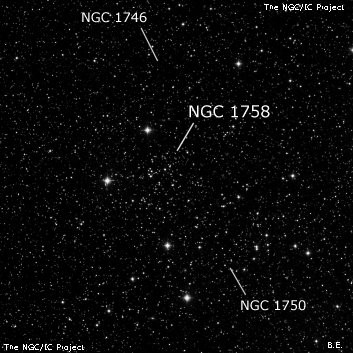
William Herschel discovered NGC 1758 = H VII-21, along with NGC 1750, on 26 Dec 1785 (sweep 493) and described "a cluster of pretty compressed stars with many extremely small stars mixed with them." Auwers' re-reduced position places H VII-21 at 05 04 24 +23 48, matching this 10' group of stars.
A 1992 article "Probable open clusters NGC 1750 and NGC 1758 behind the Taurus dark clouds" (http://adsabs.harvard.edu/abs/1992BaltA...1..125S0) concludes that NGC 1758 and NGC 1750 may be true open clusters are different distances and a 1999 article (http://link.springer.com/article/10.1023%2FA%3A1002118814371?LI=true) arrives at the same conclusion. Another 1998 article "The Overlapping Clusters NGC 1750 and NGC 1758" in A&AS, 333, 471 concluded there was at least 1 cluster in the area (but could not conclude it was a double cluster) and that NGC 1746 was not a cluster. Finally, in a Feb 2005 S&T article, James Kaler states that "N1750 and N1758 are probably two different clusters separated along our line of sight by 500 light years, but they appear to fall almost directly atop each other"
400/500mm - 17.5" (1/19/91): about two dozen stars visible at 100x. Moderately large, roundish group comprising one of the subgroups of NGC 1746 on the east side. Located between two mag 8 stars (oriented N-S) and a mag 7 star (HD 32575) is close east. Includes five mag 13 stars at the east side. The larger NGC 1750 group is close SW also within NGC 1746.
Notes by Steve Gottlieb